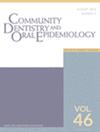Sociodemographic Inequalities in Oral Health-Related Quality of Life in Older Adults: 15 Years Follow-Up of the 1932 and 1942 Birth Cohorts in Sweden
Abstract
Objectives
Focusing on two birth cohorts of older adults, this study aimed to (1) describe the development of oral health-related quality of life (OHRQoL) across time from 2007 to 2022 and (2) assess sociodemographic inequalities in OHRQoL and whether these inequalities remain stable, widen or narrow during the follow-up period.
Methods
In 1992 and 2007 the 1942 and 1932 birth cohorts living in the Swedish counties of Örebro and Östergotland participated with 6346 (response 71.4%) and 3735 individuals (response 71.9%), respectively. Of the 6346 1942 birth cohort participants, 2479 (38.5% of baseline) completed postal follow-ups in 1997, 2002, 2007, 2012, 2017 and 2022. Of the 3735 1932 birth cohort participants, 751 (20% of baseline) participated also in 2012, 2017 and 2022. Oral impacts of daily performance (OIDP) and socio-demographic characteristics were assessed at each survey year. A cohort table depicted the prevalence rates of OIDP (OIDP > 0) across time, disentangling age, period and cohort effects. Logistic mixed models with interaction terms of each socio-demographic covariate and time were used to test differences in socio-demographic inequalities of oral impacts over time.
Results
Between 2007 and 2022, OIDP > 0 varied from 22.7% to 28.7% in the 1932 birth cohort (age 75–90) and from 25.3% to 26.6% in the 1942 cohort (age 65–80). Mixed models revealed that cluster specific odds ratios (ORs) for OIDP > 0 varied from 0.2 to 2.5 with respect to avoidance of dental care due to cost and health perceptions in the 1942 cohort. Corresponding OR estimates in the 1932 cohort were 0.2 and 2.1. In both cohorts, inequality estimates according to country of birth and education were smaller in 2022 than in 2007. In the 1932 cohort, inequality according to sex was larger in 2022 than in 2007.
Conclusion
Higher prevalence of oral impacts with increasing age and overtime were observed for both cohorts. Narrowing and widening of oral health socio-demographic disparities occurred. Further examination of the interaction of socio-demographic factors with age or time may allow for targeted policy strategies aimed to alleviate oral health disparities in older ages.

 求助内容:
求助内容: 应助结果提醒方式:
应助结果提醒方式:


